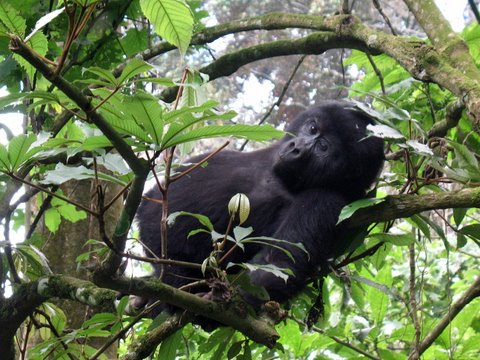|
 Among
primates, only the great apes (bonobo, chimpanzee, gorilla and urangutan)
build temporary nests each night, to provide support during sleep.
Gorilla nests are usually constructed from the surrounding plant
material, on the ground or in trees. Nests provide crucial information
to primate researchers about the movements and home ranges of the
animals, group demography, and preferred habitats. Most great ape
censuses rely on nest counts and the counting and description of nests
provides a tool for establishing population size, density and group
dynamics. Nest observation may even provide information on unhabituated
gorillas, such as their whereabouts, and other aspects of their ecology. Among
primates, only the great apes (bonobo, chimpanzee, gorilla and urangutan)
build temporary nests each night, to provide support during sleep.
Gorilla nests are usually constructed from the surrounding plant
material, on the ground or in trees. Nests provide crucial information
to primate researchers about the movements and home ranges of the
animals, group demography, and preferred habitats. Most great ape
censuses rely on nest counts and the counting and description of nests
provides a tool for establishing population size, density and group
dynamics. Nest observation may even provide information on unhabituated
gorillas, such as their whereabouts, and other aspects of their ecology.
This study was designed to determine if Bwindi’s Mountain gorillas are
selective in their choice of night nest materials, as well as of the
site where to build the nest.
The study focused on a single Mountain gorilla group (the ‘Mubare
group’) living on the west side of Bwindi Impenetrable National Park.
This group was habituated for tourism and research, and its home range
is close to Buhoma (altitude 1,450 m.a.s.l.). At the time of the study,
the group consisted of fourteen members; one silverback, nine females
and four infants. The study was conducted during four 1 to1.5 - month
field visits (June-July of 1998, 1999 and 2000, plus December 1999 -
January 2000). The nest sites were visited within 24 hours after they
were built (indicated by presence of fresh dung), and described in terms
of date, location, number of nests, nest builder, forest/ habitat type,
nest type, whether the nest site was re-used (based on the presence of
old nests). All plant species used in nest construction were identified
and their respective abundance within two metres from the nests was
recorded.
Forty seven nest sites were visited, and 446 nests described. The nest
builder/occupant was determined by the Schaller’s method developed in
the Virunga region (the diameter of dung relates to different age
categories of Mountain gorillas, and the presence of white hair
indicates a silverback).
Ground nests were dominant (96.5%) compared to tree nests. 99.7% of
plants used in nest building were herbs. The median number of different
species used in an individual nest was three; however, some nests only
contained one species, while others contained as many as ten. Some of
the genera recorded were; Pteridium, Triumfetta, Panicum, Mimulopsis,
Brillantasia, Urera, Rubus and Momordica.
A total of 62 different species were identified from all the recorded
nests. These were only part of the total available plant species (108)
within two metres of the nests.
The author recommends that future gorilla studies incorporate nesting
behaviour and nesting characteristics. |


 Among
primates, only the great apes (bonobo, chimpanzee, gorilla and urangutan)
build temporary nests each night, to provide support during sleep.
Gorilla nests are usually constructed from the surrounding plant
material, on the ground or in trees. Nests provide crucial information
to primate researchers about the movements and home ranges of the
animals, group demography, and preferred habitats. Most great ape
censuses rely on nest counts and the counting and description of nests
provides a tool for establishing population size, density and group
dynamics. Nest observation may even provide information on unhabituated
gorillas, such as their whereabouts, and other aspects of their ecology.
Among
primates, only the great apes (bonobo, chimpanzee, gorilla and urangutan)
build temporary nests each night, to provide support during sleep.
Gorilla nests are usually constructed from the surrounding plant
material, on the ground or in trees. Nests provide crucial information
to primate researchers about the movements and home ranges of the
animals, group demography, and preferred habitats. Most great ape
censuses rely on nest counts and the counting and description of nests
provides a tool for establishing population size, density and group
dynamics. Nest observation may even provide information on unhabituated
gorillas, such as their whereabouts, and other aspects of their ecology.